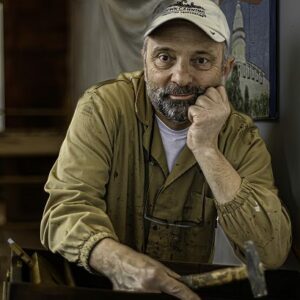John Canning & Co.'s Team Spotlight
Renato Tavecchio

We are proud to showcase the talented Renato Tavecchio, our Master Craftsman, in our Company Spotlight. Renato brings over 30 years of architectural woodwork restoration and conservation experience to our team. His knowledge of various architectural time periods including Renaissance, Baroque, Neoclassical, and Empire styles is invaluable to our work. Renato's expertise has been an essential part of the successful restoration of our significant historic projects. We are honored to have Renato on our team and are excited to share his artistry with you.
How did you get started in the field?
I usually say that I was born in the workshop, as my father was a cabinet maker and became an antique furniture restorer. When I was young, I started to spend time with him in the shop, watching him work and seeing all the woodworking tools and techniques. At around 12 or 13 years old, I began to work as his apprentice in the afternoon after school. At 14, I attended a trade art and woodworking school while continuing to work at my father’s workshop. I continued this until he passed away when I was 18, after which I took over the business. When I moved to the United States, my brother took over the family business, and continues to run it to this day.
How long have you been working at this job?
I started working for the company between 1994 & 1995, though I have been working in the field since I was young. My first job with Canning was at the Old State House in Hartford, Connecticut, woodworking on site and restoring the Senate Chamber desks and chairs. Since then, I have worked with Canning at many projects including Yale University, a few residences in Connecticut, the Boston Public Library, and the Cosmos Club in Washington D.C. Each job has allowed me to strengthen my skills and knowledge of art history, furniture styles, construction techniques, wood essences, finishing methods and materials, and other woodworking and conservation techniques.

What does a day in your job look like?
I like to start my work days early, and usually set a target for the work I would like to complete that day before I begin. Once I begin working, I will work until the task is complete – sometimes an 8 hour workday is not enough to complete the work at the quality that I would like to. I have learned to be flexible with my schedule as much of my job includes traveling cross country with my toolbox in tow. Often, each day on the job is a little different, and each job I take on becomes a new challenge for me to take on and complete. My job specifically deals with woodworking and requires knowledge of furniture construction techniques, marquetry, carving, stripping, and finishing techniques. Any given day could utilize one or more of these techniques, allowing me to constantly use my knowledge and continue to learn more about the art of woodworking.

What are some challenges you face at your job, and how do you solve them?
I always like to challenge myself with new and interesting jobs, and like to keep myself out of my comfort zone so that I can learn and grow in my career. I can remember a particularly challenging project at the Lockwood Matthews Mansion where I had to repair the damaged veneer work on the walls. For this project, I needed to use the original, historic tools and techniques, which included using hot glue and a hot iron. This made for a very difficult process, especially because the work was done on a vertical surface, and you needed to kneel to reach the damaged areas. To overcome this difficult part of the project, I learned the techniques and worked to master the tools so that the process became easier to manage and produced high-quality work.

Do you have a favorite project or a project you are the proudest of?
The complicated project at the Lockwood Matthews Mansion mentioned above is one that I feel particularly proud of, especially due to the difficulty of the work. I feel that I produced high-quality repairs, and truly challenged myself to learn the new tools and techniques, which helps to make me a better craftsman. I still look back on this project fondly, and feel proud of the work I accomplished.

What advice do you have for someone who is looking to get into the preservation field?
The key qualities for someone starting in our industry to possess are passion and patience. You must have passion for the art and preserving the work that previous generations have created. You must also have a lot of patience to keep working and learning. Both qualities, patience especially, will pay off in the long run. Do not be afraid to ask questions as well, because people in the field are always willing to share their craft with you and exchange knowledge. That is a part I love about my job; there is always something new to learn, and nobody in the industry knows everything there is to know about the business. People are constantly sharing tips and tricks and are willing to help you get better – all you have to do is ask.
